What are the chemical senses beyond taste and smell? (3)
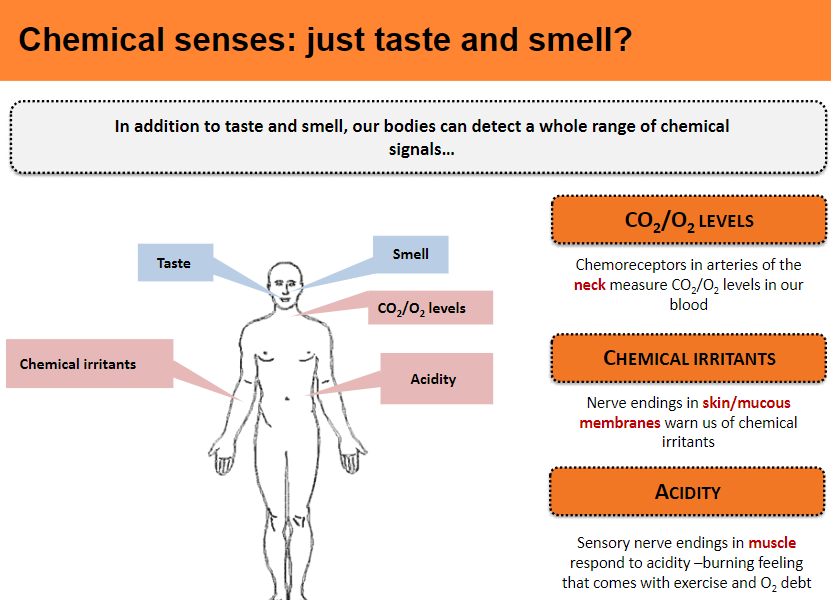
Chemoreceptors that detect CO₂/O₂ levels in the blood.
Nerve endings that detect chemical irritants.
Sensory nerve endings in muscles that respond to acidity.
What role do chemoreceptors in the arteries of the neck play? (2)

They measure CO₂ levels in the blood.
They measure O₂ levels in the blood.
What do nerve endings in the skin and mucous membranes detect? (1)
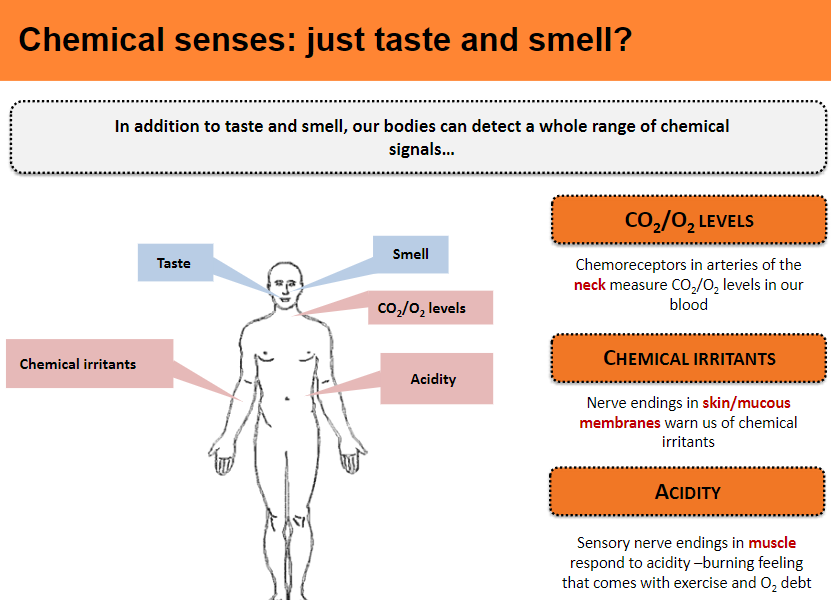
Chemical irritants.
What do sensory nerve endings in muscles respond to? (2)
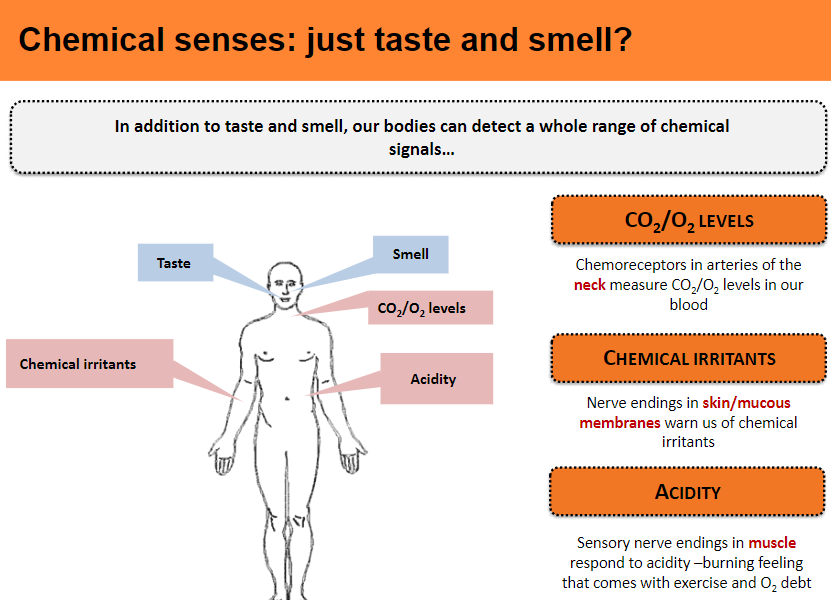
Acidity.
The burning feeling associated with exercise and oxygen debt.
Is taste innate or learned? (4)
Some taste preferences are inborn ("innate").
Humans naturally enjoy sweet flavors and avoid bitter ones, an evolutionary adaptation to distinguish food sources and avoid toxins.
Experience can modify innate preferences.
Humans can learn to tolerate or enjoy bitter substances like coffee.
Picture demonstrating the perception of flavour:
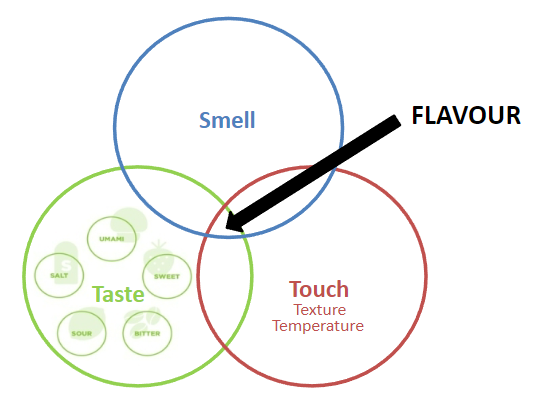
What are the organs of taste and their roles? (4)
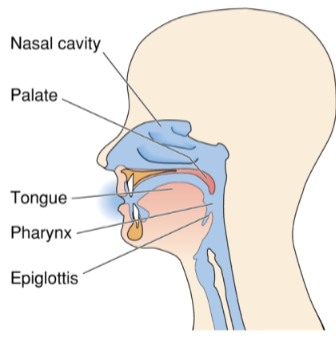
Tongue: Primary organ of taste.
Palate:
Roof of the mouth separating oral and nasal cavities.
Contains taste buds.
Epiglottis:
Leaf-shaped cartilage covering the laryngeal inlet.
Contains taste buds.
Pharynx and Nasal Cavity:
Allow odors to pass to the nasal cavity to be detected by olfactory receptors.
What are the structures on the tongue involved in taste? (6)
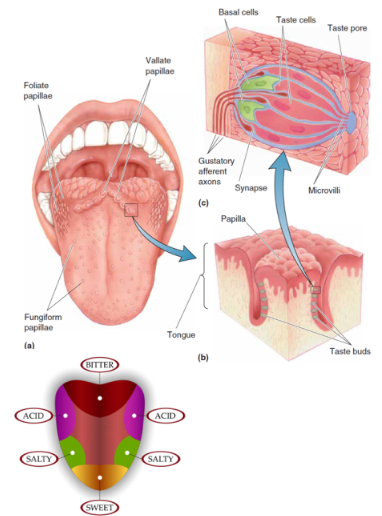
Papillae:
Ridge-shaped (foliate)
Pimple-shaped (vallate)
Mushroom-shaped (fungiform)
Taste Buds:
Contain taste receptor cells for detecting taste stimuli
Surrounded by basal cells, which are precursors to new taste cells
Connected to gustatory afferent axons, which transmit taste signals to the brain
What are taste receptor cells, and how do they function in transmitting gustatory information? (5)
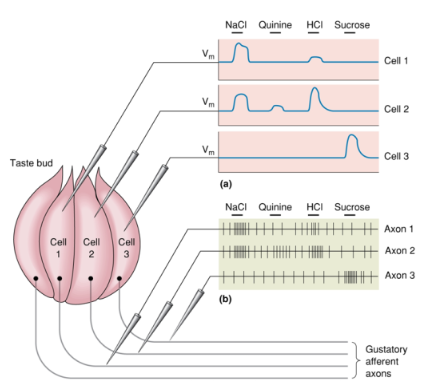
Taste receptor cells respond to different taste stimuli (e.g., salt, bitter, sour, sweet) by changing their membrane potential.
These cells express specific taste receptors, primarily responding to one of the five basic tastes. Varying sensitivities to taste stimuli.
They form synapses with gustatory afferent axons.
This connection enables the transmission of gustatory information to the brain.
How is saltiness transduced in taste? (1)
Saltiness is transduced through ion channels.
How is sourness transduced in taste? (1)
Sourness is transduced through ion channel mechanisms.
What is the transduction mechanism for saltiness? (3)

Sodium ions (Na+) pass through Na+ selective channels down their concentration gradient.
This depolarizes the taste cell, activating voltage-gated calcium (Ca2+) channels, leading to vesicular neurotransmitter release and activation of gustatory afferents.
A special Na+ selective channel (amiloride-sensitive) detects low concentrations of salt. This channel is insensitive to voltage and remains generally open.
What is the transduction mechanism for sourness? (4)

Protons (H+) are the key determinants of acidity and sourness.
H+ may affect sensitive taste receptors in several ways, although these processes are not fully understood.
It is likely that H+ passes through proton channels and binds to, blocking K+ selective channels.
This results in depolarization of the taste cell, activating voltage-gated sodium (VGSC) and voltage-gated calcium (VGCC) channels, leading to vesicular neurotransmitter release and activation of gustatory afferents.
What is the transduction mechanism for bitterness, sweetness, and umami? (1)

Bitterness, sweetness, and umami are transduced via G-protein coupled receptor (GPCR) mechanisms through T1 and T2 taste receptors.
What are the transduction mechanisms for bitter, sweet, and umami tastes, and which receptors are involved? (3)
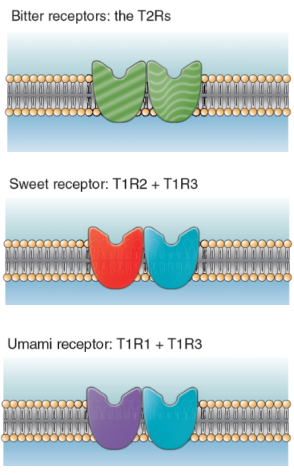
Bitter substances are detected by the T2Rs.
Sweet substances are detected by the T1R2 and T1R3 proteins.
Umami substances are detected by the T1R1 and T1R3 proteins.
What is the transduction mechanism for bitterness? (4)

Bitter tastants bind to T2R, which is coupled to the G-protein Gq.
This stimulates the enzyme phospholipase C (PLC), leading to the production of inositol triphosphate (IP3).
IP3 activates a special type of Na+ ion channel and releases Ca2+ from intracellular storage sites.
Both actions depolarize the taste cell, eliciting the release of ATP and activating gustatory afferents.
What is the transduction mechanism for sweetness? (2)

Sweet tastants bind to a dimer receptor formed from T1R2 and T1R3, which is coupled to the G-protein Gq.
The same signal transduction mechanism as bitterness occurs.
Why do we not confuse bitter and sweet tastes? (2)

Taste cells express either bitter or sweet receptors, not both.
In turn, bitter and sweet taste cells connect to different gustatory axons.
What is the transduction mechanism for umami? (3)

Umami tastants bind to a dimer receptor formed from T1R1 and T1R3, which is coupled to the G-protein Gq.
The same signal transduction mechanism as bitterness and sweetness occurs.
It shares the T1R3 protein with sweetness, with the T1R subunit determining specificity to umami.
Why do we not confuse bitter, sweet, and umami tastes? (2)

Taste cells express either bitter, sweet, or umami receptors.
In turn, bitter, sweet, and umami taste cells connect to different gustatory axons.
What is the flow of taste information to the CNS? (4)
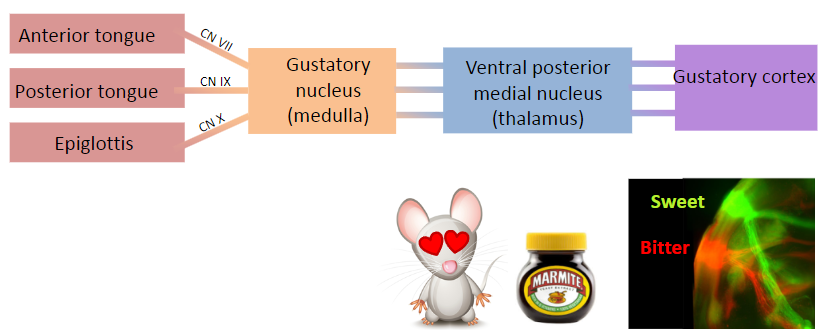
The main flow of taste information is from taste cells to gustatory axons.
Gustatory axons travel to the gustatory nucleus in the medulla.
From the gustatory nucleus, the information travels to the ventral posterior medial nucleus in the thalamus.
Finally, the information reaches the gustatory cortex.
What are the cranial nerves that carry gustatory axons and bring taste information to the brain? (3)
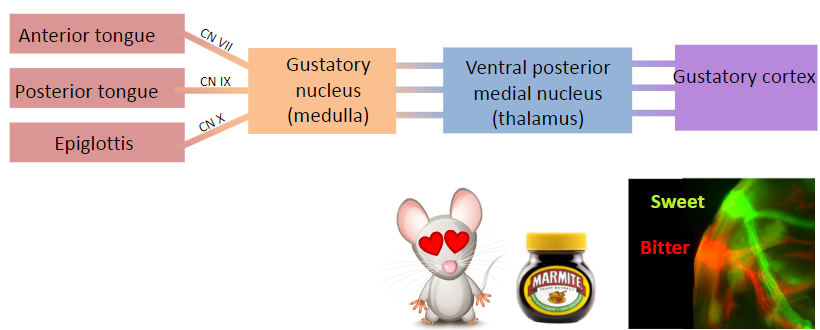
The facial nerve (VII).
The glossopharyngeal nerve (IX).
The vagus nerve (X).
Is smell innate or learned? (2)
Some of our smell preferences are inborn (or "innate").
However, experience can strongly modify our innate preferences.
Why is Smell a mode of communication (3)

In some animals, pheromones are important signals for reproductive behaviors, marking territories, and indicating aggression or submission.
Pheromones are olfactory stimuli used for chemical communication between individuals.
The importance of pheromones in humans is unclear.
What is the olfactory epithelium (3)
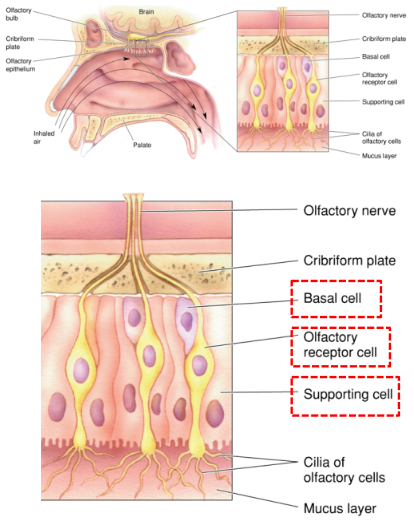
Olfactory receptor cells: These are the site of transduction and are genuine neurons, unlike taste receptor cells.
Supporting cells: Their function is to produce mucus, allowing odorants to dissolve in the mucus layer before contacting the cilia of olfactory receptor cells.
Basal cells: These are immature olfactory receptor cells that can differentiate into mature olfactory receptor cells. Olfactory receptor cells continuously grow, degenerate, and regenerate.
What is the mechanism of olfactory transduction? (5)
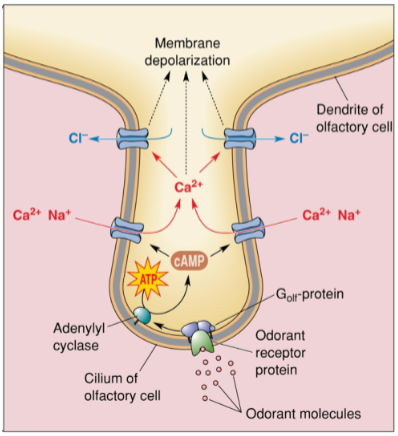
Odorant molecules bind to odorant receptor proteins on the cilia of olfactory receptor cells.
This activation leads to the activation of the olfactory-specific G-protein (Golf).
Adenylate cyclase is activated, increasing cAMP formation.
cAMP-activated channels open, allowing Na+ and Ca2+ influx.
Ca2+-activated chloride channels open, enabling Cl- efflux, which causes membrane depolarization of the olfactory neuron.
Picture demonstrating Olfactory receptor neurons:
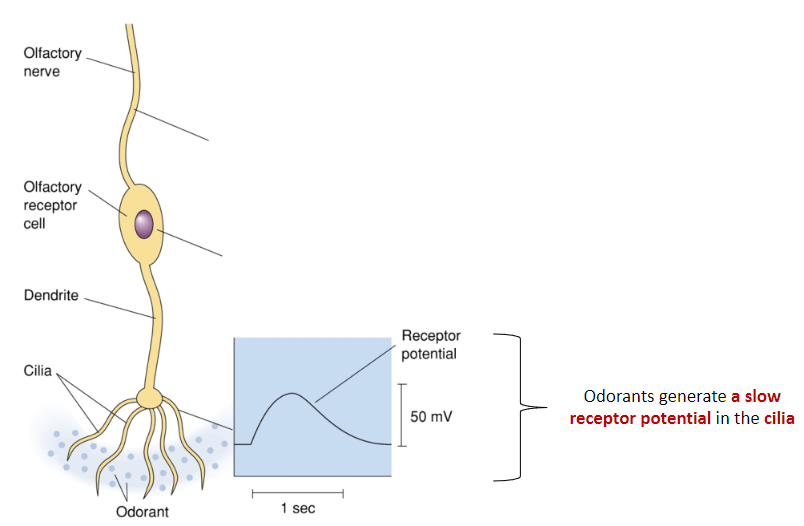
What is the flow of smell information to the CNS? (4)
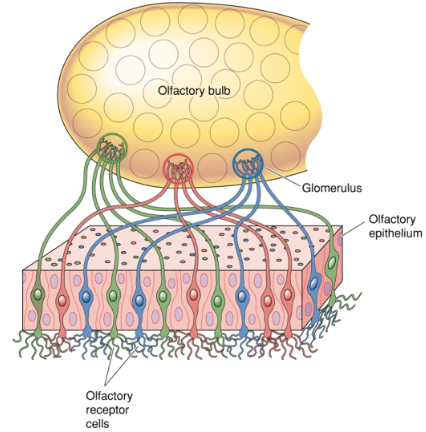
Olfactory receptor cells send their axons into the olfactory bulb.
Olfactory receptor cells that express the same receptor proteins project to the same glomeruli in the olfactory bulb.
Signals are relayed within the glomeruli.
These signals are then transmitted to higher regions of the brain for further processing.
What is the flow of smell information to the CNS? (6)
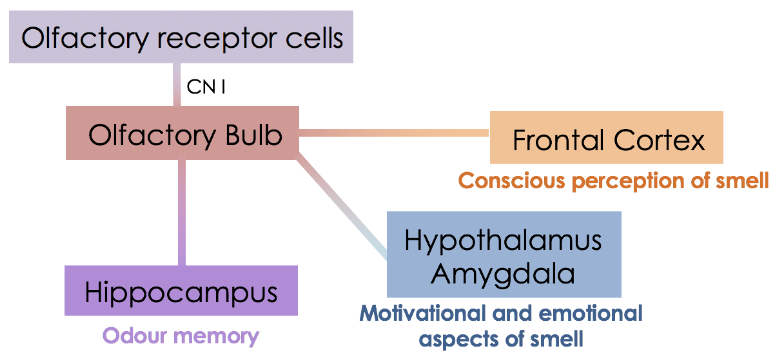
Olfactory receptor cells detect odorants.
The information is transmitted via Cranial Nerve I (CNI) to the olfactory bulb.
Signals from the olfactory bulb are sent to the hippocampus for odor memory processing.
The information also reaches the frontal cortex for the conscious perception of smell.
The hypothalamus processes the motivational aspects of smell.
The amygdala is involved in the emotional responses to smells.
What is population coding for gustation and olfaction? (4)
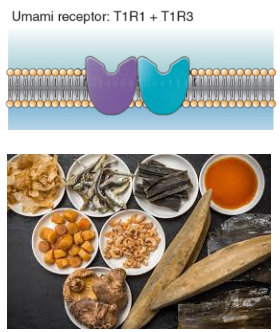
In population coding, a large number of broadly tuned neurons work together to specify the properties of a stimulus (e.g., taste or smell).
Gustatory and olfactory axons and the neurons they activate in the brain respond broadly to stimuli.
The brain can only distinguish between specific tastes and smells with a large population of neurons, each having different response patterns.
Gustatory and olfactory receptor cells may express only one specific receptor protein.
What is an example of population coding for olfaction? (4)
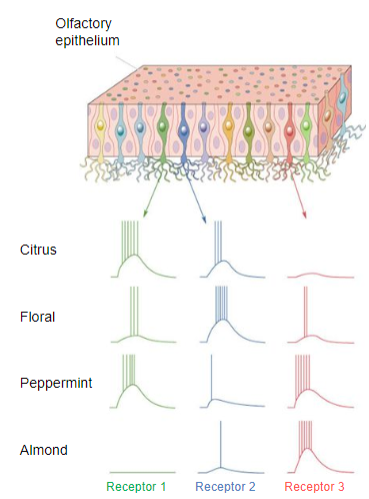
Olfactory receptor cells express a single olfactory receptor protein, but each cell can respond to different odours with varying preferences.
The brain distinguishes smells (e.g., citrus) through the combination of responses from multiple receptor cells.
Humans can discriminate at least one trillion different combinations of odour stimuli.
When presented with a citrus smell, none of the individual receptor cells can distinguish it from other odours on their own.
What is the definition of a chemoreceptor? (1)
A chemoreceptor is a protein that is responsive to chemical stimuli.
What is a glomerulus in the context of olfaction? (1)
A glomerulus is a cluster of nerve endings in the olfactory bulb.
What is gustation? (1)
Gustation is the perception of taste.
What is the gustatory nucleus? (1)
The gustatory nucleus is a region of the medulla that conveys gustatory signals.
What is olfaction? (1)
Olfaction is the perception of smell.
What is the olfactory bulb? (1)
The olfactory bulb is the region to which olfactory receptor cells project.
What is the olfactory cortex? (1)
The olfactory cortex is the region of the cortex that perceives smell.
What is the olfactory epithelium? (1)
The olfactory epithelium is a mucus-covered layer into which the cilia of olfactory receptor cells protrude to facilitate odour detection.
What is an olfactory receptor cell? (1)
An olfactory receptor cell is a neuronal cell responsible for odour detection.
What is a papilla? (1)
A papilla is a small, rounded protuberance on the tongue.
What is a pheromone? (1)
A pheromone is a chemical substance produced and released into the environment by an animal that affects the behaviour or physiology of others of its species.
What is population coding? (1)
Population coding refers to the temporal and spatial frequencies of sensory signals from multiple neurons.
What is the primary gustatory cortex? (1)
The primary gustatory cortex is the region of the cortex that perceives taste.
What is a taste bud? (1)
A taste bud is a cluster of taste receptor cells.
What is a taste receptor cell? (1)
A taste receptor cell is a cell responsible for taste detection.
What is the ventral posterior medial nucleus? (1)
The ventral posterior medial nucleus is a sensory thalamic nucleus through which gustatory signals are transmitted.